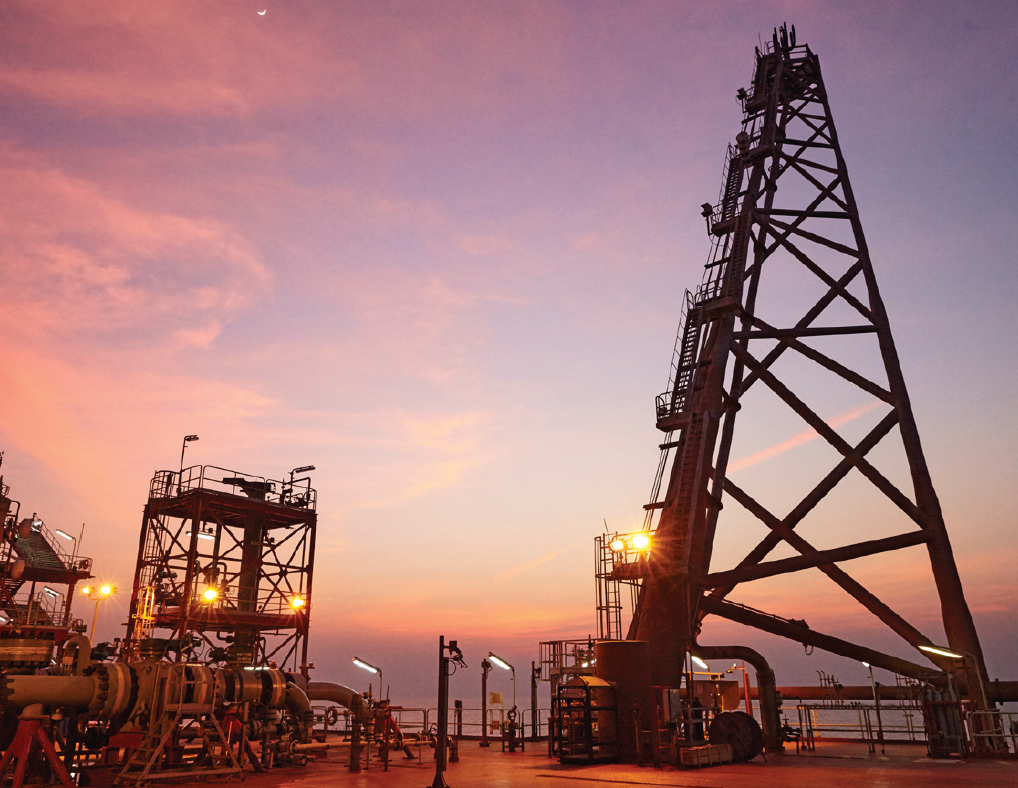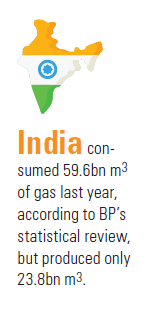Price controls throttle India’s production potential [Gas in Transition]
India’s state-run developers have had little reason to boost production from mature gas fields, which account for the bulk of national production, owing to artificially depressed prices.
While national production is finally on the rise once more, thanks to the recent start-up of several deepwater fields off the country’s eastern coastline, New Delhi’s reluctance to fully deregulate pricing for domestic production has hamstrung the country’s wider upstream potential.
India has adopted a mish-mash of regulated, quasi-regulated and deregulated gas prices. The government sets the price for production from fields awarded under the nomination and New Exploration Licence Policy (NELP) models every six months, with a few exceptions. This is based on the weighted average gas price at hubs in the US, Canada, the UK and Russia.
At the same time, the government also sets a higher price ceiling for production from deepwater, ultra-deepwater and high-pressure, high-temperature (HPHT) fields that entered production after January 1, 2016. Finally, fields whose development the government approved after February 2019 enjoy pricing and marketing freedoms.
But with the vast majority of the country’s gas coming from regulated and semi-regulated gas fields, enthusiasm for brownfield developments has been muted in recent years.
Breaking even
The country’s largest gas producer, state-run Oil and Natural Gas Corp (ONGC), has long complained that the regulated price for gas production from nominated and NELP blocks falls below their breakeven line. It has also argued that the price premium for challenging production falls below what is needed to develop some of the country’s deepwater reserves.
The government announced on September 30 that the price of gas from nomination or NELP blocks would increase by 62% for the six months from October 1 to $2.90/mn Btu from $1.79. The price ceiling for challenging fields was increased from $3.62/mn Btu to $6.13.
While the price hike was welcome news for both ONGC and state-run Oil India Ltd (OIL), given that conventional gas prices had been at multi-year lows, the bump is unlikely to see their gas business turn a profit.
“A consequence of the current pricing system is that Indian gas production has been profit-limiting at best to loss-making at worst. ONGC had reported that their breakeven price for nomination fields was at ~$3.60/mn Btu, and even with the most recent revision this was not covered,” Rystad Energy analyst Kaushal Ramesh tells NGW.
Such commercial constraints saw India’s net gas production shrink from 39.75bn m3 in financial year 2012-2013 to just 27.78bn m3 in 2020-2021. Driving this slump was a sharp fall in production from Reliance India Ltd (RIL) and BP’s deepwater KG-DWN-98/3 (KG-D6) block in the Krishna Godavari (KG) basin.
Deepwater driver
After coming onstream in 2009, and reaching a peak of 61.5mn m3/day in 2010, geological complexities led to a freefall in KG-D6’s production that eventually saw the last of the acreage’s original fields go offline last year.
RIL and BP were dragged into a dispute with the government over accusations that they had gold-plated their expenses and that they had curbed production to try to force the government to regulate prices. The two sides eventually settled their dispute, paving the way for RIL and BP to begin developing new KG-D6 fields under the premium pricing model.
The first of these new fields came on stream in December 2020 and a ramp up in the block’s output this year has helped bring an end to the country’s multi-year production slump, according to the Petroleum Planning & Analysis Cell (PPAC). For example, India produced 2.92bn m3 of gas in August compared with 2.43bn m3 in the same month of 2020.
It is not just KG-D6 that promises to boost Indian gas production, however, with ONGC having pumped first gas from the neighbouring KG-DWN-98/2 (KG-D5) block in September. And yet, while KG-D5 and KG-D6’s success is welcome – especially for energy planners worrying over the country’s more than 50% dependence on imports – it also speaks to a missed opportunity for the country’s nominated fields.
Market realities
“The fields where prices are governed by the modified Rangarajan formula cannot thrive at such low prices,” the vice president and co-head of corporate ratings at ICRA, Prashant Vasisht, tells NGW.
 He added that the government had been reluctant to fully deregulate gas prices over concerns of the impact such a move would have on critical industries, such as fertiliser production, city gas distribution (CGD) and power generation.
He added that the government had been reluctant to fully deregulate gas prices over concerns of the impact such a move would have on critical industries, such as fertiliser production, city gas distribution (CGD) and power generation.
Ramesh echoes this sentiment, noting: “In a price sensitive country, higher prices would not be well received by end-users, particularly sectors such as fertilisers, which make up the single largest gas consuming sector in India. Therefore, this is not easy to pull off, and the government appears to be taking a phased approach toward deregulation.”
Higher pricing for production from KG-D5 and KG-D6, which both fall under the premium price ceiling model, has inarguably helped to boost output. However, higher deepwater production is unlikely to be enough to justify full deregulation of gas pricing, given the current level of demand side pricing sensitivity.
Distortions in India’s gas price system have left both the government and its majors in a tight spot. New Delhi has repeatedly warned both ONGC and OIL that they will have undeveloped fields confiscated for future bid rounds. But state-run developers are struggling to make a commercial case for mature field development given current gas prices.
It appears, however, that it will take a growing tolerance among buyers toward higher prices before the government can embrace price deregulation and resolve this deadlock. The government’s decision in August, then, to allow gas from deregulated fields to be sold on the Indian Gas Exchange (IGX) could be exactly what is needed on this front.
Ramesh said: “The government has started to allow some domestic production to trade on the [IGX], which was previously limited to trading LNG. Allowing more domestic production to trade on the exchange will certainly help deregulation.”



